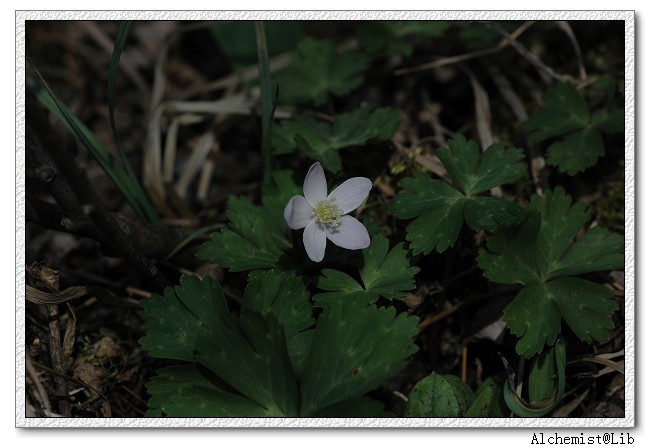鹅掌草 Anemonastrum flaccidum
- Scientific Name: Anemonastrum flaccidum (Fr.Schmidt) Mosyakin
- Ref: Phytoneuron 2018-55:5. 2018
- Synonyms:
- Anemone amagisanensis Honda
- A. anhuiensis Y.K.Yang, N.Wang & W.C.Ye
- A. baicalensis subsp. flaccida (F. Schmidt) Ulbr.
- A. baicalensis var. laevigata A.Gray
- A. flaccida Fr.Schmidt
- A. flaccida var. anhuiensis (Y.K.Yang, N.Wang & W.C.Ye) Ziman & B.E.Dutton
- A. flaccida var. hirtella W.T.Wang
- A. flaccida var. hofengensis (W.T.Wang) Ziman & B.E.Dutton
- A. flaccida var. tagawae (Ohwi) M.N.Tamura
- A. hofengensis W.T.Wang
- A. laevigata (A.Gray) Koidz.
- A. soyensis H.Boissieu
- A. tagawae Ohwi
- Anemonidium flaccidum (Fr.Schmidt) Christenh. & Byng
- Anemonoides flaccida (Fr.Schmidt) Holub
- Anemonoides soyensis (H.Boissieu) Holub
- Arsenjevia flaccida (Fr.Schmidt) Starod.
- Chinese Common Name: 鹅掌草 ézhǎng∙cǎo, 二轮七 èrlún∙qī, 蜈蚣三七 wúgōng sānqī, 林荫银莲花 línyīn yín∙liánhuā
- Japanese Common Name: ニリンソウ [二輪草] nirinsō
- Family: Ranunculaceae
- Genus: Anemonastrum
- Distribution: Forests and streamsides in valleys, shady grassy places; 400–3000 m. S Anhui, Guizhou, W Hubei, Hunan, S Jiangsu, Jiangxi, Sichuan, NW Yunnan, NW Zhejiang [Japan, Russia (Far East, Sakhalin)].
- Photo: 04/11/2009, Mt. Tianmu, Zhejiang
Rhizome branched, oblique, short, 5--10(--15) mm in diam., sometimes also prostrate, stolonlike, long, 1--1.5 mm in diam. Scalelike leaves 3 or 4, 5--8 × 5--8 mm, several with distinct leaf blade developing after anthesis. Leaves solitary on rhizome (petiole basally sheathing) and 2 or 3 at base of reproductive shoots (petiole basally slightly dilated); petiole 10--25 (--30) cm, hirsute or sparsely puberulent to glabrous; leaf blade 3-sect, reniform-pentagonal, 3.5--8 × 6--10(--14) cm, adaxially sparsely puberulent, base cordate, margin denticulate, apex obtuse or acute; segments with petiolule 1--2 mm or absent; central segment 3-lobed, rhombic, ultimate lobules triangular or broadly lanceolate; lateral segments 2-parted, obliquely flabellate. Scapes 1--3, 15--25(--40) cm, hirsute or sparsely puberulent to glabrous; cyme 2- or 3(--5)-flowered. Involucral bracts 3(--5), subsessile; bract blade unequally 3-lobed to deeply so, 3--6 × 5--8 cm, sparsely puberulent; lobes usually rhombic, base cuneate, margin shallowly incised, apex obtuse. Bracteoles 1 or 2, 6--15 × 3--7 mm, lanceolate, entire or 3-lobed. Pedicel 4--7 cm, sparsely puberulent. Sepals (4 or)5(--8), persistent, white, yellowish, pink, or reddish purple, obovate to elliptic, 5--10(--20) × 3--5(--10) mm, glabrescent or sparsely appressed puberulent, basal veins 5--9, vein anastomoses 7--9, base and apex rounded. Stamens 3--5 mm; filament filiform; anther ellipsoid or cylindric, apex mucronate or apiculate, connective narrow. Ovary ovoid, ca. 2 mm, densely puberulent, base narrowed or rounded; style obscure; stigma turbinate, broadly ovoid, or globose. Achene body ovoid, 3--4 × 1.5--2.5 mm, puberulent (hairs ca. 0.1 mm) or glabrate; style very short and thick. Fl. Apr--Aug. (Flora of China)

04/07/2007, Qingliang Peak, Zhejiang
